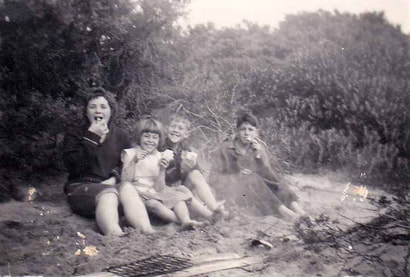 Allen family barbecue, Lake Lister, c. 1956. From left, Glenda (a family friend), Leonie, Peter and Graeme.
Allen family barbecue, Lake Lister, c. 1956. From left, Glenda (a family friend), Leonie, Peter and Graeme. Lake Lister was a magical place - until the day two miners decided to deepen it with a few sticks of gelignite.
By Terri Allen
LAKE Lister has always been a magnet, drawing foragers, adventurers and naturalists. A large freshwater lagoon, spring-fed, it nestles between the coastal dunes and cleared farmland (once paperbark flats and heathy undulations) west of Wonthaggi on private land.
By Terri Allen
LAKE Lister has always been a magnet, drawing foragers, adventurers and naturalists. A large freshwater lagoon, spring-fed, it nestles between the coastal dunes and cleared farmland (once paperbark flats and heathy undulations) west of Wonthaggi on private land.
The wetland vegetation in the vicinity of Lake Lister is varied, as shown by lists I made in 2002 and 2008: streaked arrowgrass, water ribbons, slender twine-rush, tassel rope-rush, knobby clubrush, common reed, spiny-headed matrush, golden spray, mat water-milfoil, scented paperbark, swamp paperbark, centella, running marshflower, shiny swamp-mat, water buttons, salt angianth, swamp selaginella, common duckweed, pale rush, pointed centrolepis, zig-zag bog-rush, pithy sword-sedge, bare twig-rush, soft twig-rush, little club-rush, common onion-orchid, hundreds and thousands….
Waterbirds frequent the area: pacific black ducks, white-faced and white-necked herons, Latham’s snipe, masked lapwing, hoary-headed grebe, straw-necked and white ibis, pacific gull. At one time it was a prized snipe site.
Habitat for fish, eels, long-necked turtles, yabbies, frogs, insects and wildfowl, sheltered from the biting westerly winds and yet accessible to the shore platforms, it must have been a larder for the local Aboriginal tribe. We found middens and flakes and flints in the interdune corridor and at least one skull was found nearby in the 1950s.
Hovell on an exploratory mission from the Corinella settlement in 1827 passed this way, discovering coal at Harmers Haven. Samuel Anderson c.1836 followed in his footsteps, taking coal back to his forge on the Bass River. A coalminer and his family had two huts in the vicinity in 1841 when he mined the Harmers Haven seams. It was also thought that Lake Lister was the site where five Tasmanian Aborigines were apprehended after the killing of two sealers at Harmers Haven in 1841.
Miners in the southern part of Wonthaggi soon made their way west from the Rifle Range, forging a track through to the nearby sand dunes, discovering Lake Lister en route. Here they could fish and hunt and provide extra rations, especially during strikes.
Waterbirds frequent the area: pacific black ducks, white-faced and white-necked herons, Latham’s snipe, masked lapwing, hoary-headed grebe, straw-necked and white ibis, pacific gull. At one time it was a prized snipe site.
Habitat for fish, eels, long-necked turtles, yabbies, frogs, insects and wildfowl, sheltered from the biting westerly winds and yet accessible to the shore platforms, it must have been a larder for the local Aboriginal tribe. We found middens and flakes and flints in the interdune corridor and at least one skull was found nearby in the 1950s.
Hovell on an exploratory mission from the Corinella settlement in 1827 passed this way, discovering coal at Harmers Haven. Samuel Anderson c.1836 followed in his footsteps, taking coal back to his forge on the Bass River. A coalminer and his family had two huts in the vicinity in 1841 when he mined the Harmers Haven seams. It was also thought that Lake Lister was the site where five Tasmanian Aborigines were apprehended after the killing of two sealers at Harmers Haven in 1841.
Miners in the southern part of Wonthaggi soon made their way west from the Rifle Range, forging a track through to the nearby sand dunes, discovering Lake Lister en route. Here they could fish and hunt and provide extra rations, especially during strikes.
 Leonie Allen, Lake Lister, 1956. The cautious hand is due to the soft edges of the lake, like quicksand.
Leonie Allen, Lake Lister, 1956. The cautious hand is due to the soft edges of the lake, like quicksand. Kids from the 30s to the 60s ventured forth, following in grandparents’ and parents’ footsteps. A board walk was put in at one time, from salvaged beachwrack hauled over the dunes. One had to be careful, for the edges were soft, almost like quicksand. Some tried fishing or rabbiting or shooting. Some even sailed flat-bottomed boats there.
The story goes that a couple of miners had some gelignite that had reached its use-by date, so they decided to deepen the lake – unfortunately they cracked the underlying coffee rock so that seepage occurred. This led to the flanking dune creeping forward; it is said that a fence along this section was five fences deep, one atop the other.
Today most of the lake is dry, but a small pool flanked by lush vegetation remains. It is a quiet place, not far from the ventilation shaft of the 1926 Southern Area Tunnel.
It has been, and still is, a magical place.
The story goes that a couple of miners had some gelignite that had reached its use-by date, so they decided to deepen the lake – unfortunately they cracked the underlying coffee rock so that seepage occurred. This led to the flanking dune creeping forward; it is said that a fence along this section was five fences deep, one atop the other.
Today most of the lake is dry, but a small pool flanked by lush vegetation remains. It is a quiet place, not far from the ventilation shaft of the 1926 Southern Area Tunnel.
It has been, and still is, a magical place.